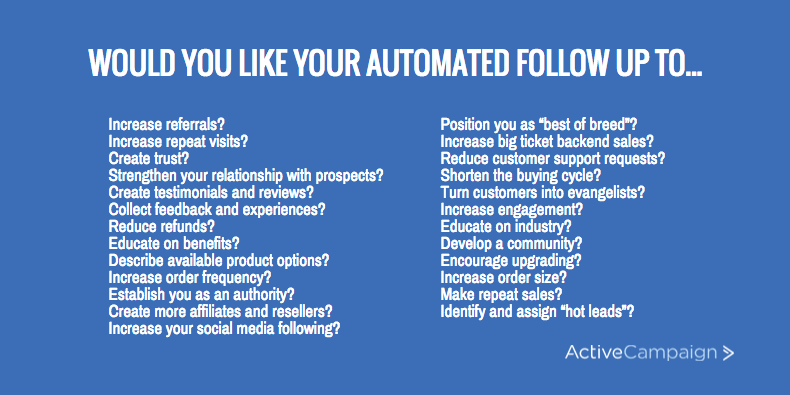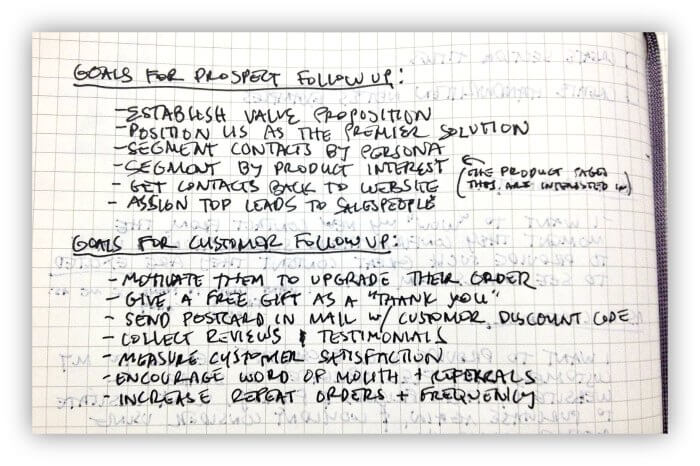Introduction
Are you using the best automated follow-up strategy?
Whether you are in the process of creating your first follow-up sequence, or you’ve been at this for years, your follow-up sequence should result from a well-defined plan for achieving your main business goals. tweet this
Unfortunately, follow-up strategy is often created on a whim or pieced together bit by bit over time. Such gradual evolution yields sequences that aren’t the product of a well-considered, overarching strategy designed to produce the best results.
What’s more, a lot has changed since you created those sequences. Powerful new marketing tools exist, you’ve gained valuable insights about your customers, your product line has transformed, and you’ve learned more about effective online marketing.
This guide to re-envisioning your follow-up is a chance to address everything you’ve put on the backburner.
Your follow-up is begging to be updated
(but your website gets all your attention)
Your automated follow-up is the neglected workhorse of your online marketing, and that’s a shame. Automated follow-up is one of the most powerful tools at your disposal. Nearly all your leads and customers experience it. Marketers obsess over the smallest details of their websites, yet might go months without thinking about automated follow-up.
Every day, your automated follow-up brings contacts back to your site, builds relationships with them, creates and nurtures qualified leads, drives conversions, boosts customer satisfaction, and saves you loads of time. Needless to say, improving your automated follow-up is worth the effort.
Creating your best follow-up sequence ever
What follows is a seven-step process to producing a unique follow-up strategy for your business. By adhering to the steps below, you are automating as much as possible and improving the overall experience for your contacts.
Any time you spend on this pays dividends over and over as each new contact experiences your automated follow-up. In fact, by spending time on automated follow-up, you are investing in one of the most important aspects of your marketing.
1. Get A Fresh Start
To develop a new improved strategy, forget your old follow-up sequences. Mentally set them aside and start over from scratch with a fresh perspective.
We are shooting for a complete top-to-bottom overhaul of your automated follow-up. Modifying or adding to what exists would lead only to incremental improvements. Instead, create something entirely fresh, inspired by your desire to improve performance.
2. Pick Your Destination
We suggest developing two separate follow-up sequences — one for your leads and one for your customers. After leads become customers, you should shift from building trust and explaining why they should do business with you, to customer service, encouraging repeat purchases, and getting referrals.
As you create your new follow-up strategy, imagine the ideal experience for contacts and use it for guidance. What do you want contacts to be subject to before and after they make a purchase?
A “perfect” experience won’t happen on its own. You make it happen by envisioning it, defining it, and then working toward it.
Describe the experience you want leads/prospects to have, and do the same for the experience you want customers to endure.
Keep those descriptions short (2-3 sentences, maximum). Focus on just a couple important things you want contacts to get out of your follow-up. This step is less about making a detailed plan and more about crafting an inspiring mission statement for your automated follow-up.
Here is an example:

When you believe you captured the essence of the experience you are striving for, move on to the next step.
3. Know What You’ll Do Along The Way
While the mission statement you created describes your destination, now we need to discuss how you’ll get there.
Spend some time considering this: ideally, what would my automated follow-up do for me?

This is where you define success for your automated follow-up, so be sure to take your time.
These goals shouldn’t be specific or measurable. In fact, it’s better if they aren’t. We are just creating a wish list. In the next step, you’ll learn how to measure and achieve these goals, and we’ll make them more specific, too.
Don’t worry about how you’ll accomplish any of this — at least not yet. That stifles your creativity and needlessly lowers your ambition. Instead, focus on what you’d like to do without limiting yourself to what is feasible or realistic.
As ideas come to you, write them down in a big, unorganized list. The more ambitious the list, the better. Stretch the limits of possibility, so you create an automated follow-up sequence that does everything you want.
When you finish your list, organize it a bit.
Separate your pre-sale (lead/prospect) goals from your post-sale (customer) goals. Then, order your goals chronologically (you probably won’t be able to do this perfectly).
Your organized list might look like this (perhaps longer):

If you are satisfied with your list, check your goals against the experience you want. Are enough of the goals centered on the customer and creating a good experience for them? If you feel your goals reflect the needs of your business and the needs of your contacts, you are ready to move on.
4. Get There “By…”
Equipped with your goals and mission statement, you’re ready to outline how you’ll achieve your goals. Add “by…” statements to each goal:

Brainstorming all the ways you could accomplish these goals requires effort. Again, don’t limit yourself to what you think is feasible because you’ll disengage with some of your best ideas. List every idea you have for reaching each goal.
Don’t stop after 3-5 good ideas. Keep pushing yourself. Your first five ideas are likely conventional tactics you considered the whole time. Don’t stop there. Your best ideas might be numbers 17 and 31. If you stop at number five, you severely limit your possibilities. tweet this
If you do it right, this step generates some of the best ideas for growing your business you’ve had in a long time. Circle, star, or underline the most brilliant ideas you have.
After all that brainstorming, you’ll have an intimidating, disorganized list of ideas. Now is the time to map them out.
5. Map It Out
When planning the exact sequence of events in your automated follow-up, pen and paper come in handy. Just make sure you have plenty of paper for the first few drafts. You’ll likely scribble out and cross out many ideas.
That’s what you want.
If this is easy for you, and you aren’t wondering how it will all come together, you weren’t ambitious enough. In that case, start over and repeat the steps.
This should feel like putting together a puzzle. You have the pieces and are trying to fit them together so they guide prospects through your pipelines. Your automated follow-up should solidify your relationship with customers, all while satisfying their needs and keeping them interested.
Don’t get stuck on details. You can worry about settings and email subject lines later. For now, just flesh out the overall process and jot down the basic order of events. Feel free to make some notes if you get a flash of insight, but try and hold off getting too detailed. This is still “big picture” time.
When you’re ready to fine-tune your follow-up sequence and make it truly magnificent, try out our automation builder. If you’ve used it, you know it’s an extremely capable and easy-to-use flowchart tool. Our automation builder is designed specifically for creating automated marketing sequences. It includes everything you’ll need: “if/then” logic, ability to combine paths, “wait until” rules, and more.
Even if you use another marketing automation platform, sign up for a free trial with ActiveCampaign and use our automation builder to outline your automated follow-up. You’ll be impressed by how intuitive, quick, and powerful it is. We’ve even had customers request a standalone automation builder for flowcharting (that would be useful, but we’re focused on creating the best, most comprehensive marketing automation tool in the industry).
The goals of your automated follow-up vary depending on your business model. But, as a rule of thumb, your automated follow-up should deliver content that:
- Positions you as “best of breed”
- Differentiates you from competition
- Communicates the value you provide
- Establishes trust and nurtures relationships
- Delivers as much value as possible
- Educates prospects about product(s)
Try to evenly distribute those messages throughout your follow-up strategy.
Remember, your prospects don’t pay attention to everything you say. You might need to be somewhat repetitive to ensure they receive your core marketing messages. Don’t be afraid to repeat important points so you are confident your prospects receive your messages, even if they miss an email or five.
6. Make A Plan
When you believe your follow-up strategy offers an effective route to the destination you determined in step two and is conducive to achieving the goals outlined in step three, you are ready to get the ball rolling.
First, make a list of what you need to bring your strategy to life. You most likely need content, such as emails or free reports. But you might also need to implement entirely new processes, like refer-a-friend programs, “one-click upsell” scripts, or some graphic designs.
We suggest you use a project management application, so you can unpack your plan into actionable steps and determine the resources required for each one.
7. Learn From Where You’ve Been
Implementing your new automated follow-up strategy might take a while. Use the extra time to mine all the pertinent data from your old follow-up strategy.
Identify key metrics you used to measure performance so that you can adequately compare the new and old sequences.
Hopefully, your new follow-up strategy performs better than your old one.
You can know if that’s the case only by analyzing the numbers.
Some useful metrics might be:
- Open rates
- Link clicks
- Unsubscribe rates
- Traffic referred by email
- Sales referred by email
- Number of leads over time
- Average time to purchase
- Average lead score
- Deals that added over time
If you haven’t yet, set up our Google Analytics integration. You can track link clicks in specific emails and automations, see how contacts interact with your website, and know what purchases and goal achievements are tied to your email marketing and marketing automation.
In terms of analytics, figure out how to measure performance for the goals you created in step two and the individual components of your sequence created in step three. Define your key performance indicators performance (KPIs) and stick to a schedule for reviewing and assessing the different aspects of your follow-up.
If you repeat this process every year or so, you experiment with strategies in hopes of finding one that outperforms your proven, established follow-up. In that way, you challenge your best work and continually strive toward the ultimate follow-up sequence that automates as much as possible and produces happy, satisfied customers.
